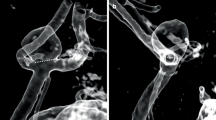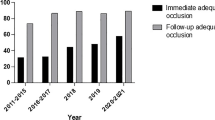Abstract
Introduction
The Woven EndoBridge (WEB) system is an innovative device under evaluation for its capacity to treat wide-neck bifurcation intracranial aneurysms. The purpose of this study is to evaluate the use of the different occlusion scales available in clinical practice.
Methods
Seven WEB-experienced neurointerventionalists were provided with 30 angiographic follow-up data sets and asked to grade each evaluation point according to the Bicêtre Occlusion Scale Score (BOSS), firstly based on DSA images only then using additional C-Arm VasoCT analysis. This BOSS evaluation was then converted into the WEB Occlusion Scale (WOS) and into a dichotomized scale (complete occlusion or not). To estimate the inter-rater agreement among the seven raters, an overall kappa coefficient [1] and its standard error (SE) were computed.
Results
Using the five-grade BOSS, raters showed “moderate” agreement (kappa = 0.56). Using the three-grade WOS, agreement appeared slightly better (kappa = 0.59). Strongest inter-rater agreement was observed with a dichotomized version of the scale (complete occlusion or not), which enabled an “almost perfect” agreement (kappa = 0.88). VasoCT consistently enhanced the agreement particularly with regards depicting intra-WEB residual filling.
Conclusion
The WOS is a consistent means to angiographically evaluate the WEB device efficiency. But the five-grade BOSS scale allows to identify aneurysm subgroups with differing risks of recurrence and/or rehemorrhage, which needs to be separated especially at the initial phase of evaluation of this innovative device. The additional use of VasoCT allows better inter-rater agreement in evaluating occlusion and specially in depicting intra-WEB persistent filling.


Similar content being viewed by others
References
Fleiss J, Levin B, Paik M (2013) Statistical methods for rates and proportions. booksgooglecom
Caroff J, Mihalea C, Dargento F, Neki H, Ikka L, Benachour N, Moret J, Spelle L (2014) Woven Endobridge (WEB) Device for endovascular treatment of ruptured intracranial wide-neck aneurysms: a single-center experience. Neuroradiology 56(9):755–761. doi:10.1007/s00234-014-1390-7
Pierot L, Moret J, Turjman F, Herbreteau D, Raoult H, Barreau X, Velasco S, Desal H, Januel A-C, Courtheoux P, Gauvrit J-Y, Cognard C, Soize S, Molyneux A, Spelle L (2015) WEB treatment of intracranial aneurysms: feasibility, complications, and 1-month safety results with the WEB DL and WEB SL/SLS in the French observatory. AJNR Am J Neuroradiol. doi:10.3174/ajnr.A4230
Papagiannaki C, Spelle L, Januel AC, Benaissa A, Gauvrit JY, Costalat V, Desal H, Turjman F, Velasco S, Barreau X, Courtheoux P, Cognard C, Herbreteau D, Moret J, Pierot L (2014) WEB intrasaccular flow disruptor-prospective, multicenter experience in 83 patients with 85 aneurysms. AJNR Am J Neuroradiol. doi:10.3174/ajnr.A4028
Caroff J, Mihalea C, Klisch J, Strasilla C, Berlis A, Patankar T, Weber W, Behme D, Jacobsen EA, Liebig T, Prothmann S, Cognard C, Finkenzeller T, Moret J, Spelle L (2015) Single-layer WEBs: intrasaccular flow disrupters for aneurysm treatment—feasibility results from a European study. AJNR Am J Neuroradiol 36(10):1942–1946. doi:10.3174/ajnr.A4369
Raymond J, Guilbert F, Weill A, Georganos SA, Juravsky L, Lambert A, Lamoureux J, Chagnon M, Roy D (2003) Long-term angiographic recurrences after selective endovascular treatment of aneurysms with detachable coils. Stroke; a J Cereb Circ 34(6):1398–1403. doi:10.1161/01.STR.0000073841.88563.E9
Meyers PM, Schumacher HC, Higashida RT, Derdeyn CP, Nesbit GM, Sacks D, Wechsler LR, Bederson JB, Lavine SD, Rasmussen P (2010) Reporting standards for endovascular repair of saccular intracranial cerebral aneurysms. AJNR Am J Neuroradiol 31(1):E12–24
Fiorella D, Arthur A, Byrne J, Pierot L, Molyneux A, Duckwiler G, Mccarthy T, Strother C (2014) Interobserver variability in the assessment of aneurysm occlusion with the WEB aneurysm embolization system. J Neurointerv Surg:1-6. doi:10.1136/neurintsurg-2014-011251
Cognard C, Januel AC (2015) Remnants and recurrences after the use of the WEB intrasaccular device in large-neck bifurcation aneurysms. Neurosurgery 76(5):522–530. doi:10.1227/NEU.0000000000000669
Caroff J, Mihalea C, Ikka L, Moret J, Spelle L (2015) Interobserver variability in the assessment of aneurysm occlusion with the WEB aneurysm embolisation system. J Neurointerv Surg. doi:10.1136/neurintsurg-2015-011862
Ernst M, Yoo AJ, Kriston L, Schönfeld MH, Vettorazzi E, Fiehler J (2015) Is visual evaluation of aneurysm coiling a reliable study end point? Stroke; a J Cereb Circ 46(6):1574–1581. doi:10.1161/STROKEAHA.114.008513
Caroff J, Mihalea C, Neki H, Ruijters D, Ikka L, Benachour N, Moret J, Spelle L (2014) Role of C-arm VasoCT in the use of endovascular WEB flow disruption in intracranial aneurysm treatment. AJNR Am J Neuroradiol 35(7):1353–1357. doi:10.3174/ajnr.A3860
Landis JR, Koch GG (1977) The measurement of observer agreement for categorical data. Biometrics 33(1):159–174
Tollard É, Darsaut TE, Bing F, Guilbert F, Gevry G, Raymond J (2012) Outcomes of endovascular treatments of aneurysms: observer variability and implications for interpreting case series and planning randomized trials. AJNR Am J Neuroradiol 33(4):626–631. doi:10.3174/ajnr.A2848
Caroff J, Mihalea C, Klisch J, Strasilla C, Berlis A, Patankar T, Weber W, Behme D, Jacobsen EA, Liebig T, Prothmann S, Cognard C, Finkenzeller T, Moret J, Spelle L (2015) Single-layer WEBs: intrasaccular flow disrupters for aneurysm treatment-feasibility results from a European study. AJNR Am J Neuroradiol. doi:10.3174/ajnr.A4369
Cloft HJ, Kaufmann T, Kallmes DF (2007) Observer agreement in the assessment of endovascular aneurysm therapy and aneurysm recurrence. AJNR Am J Neuroradiol 28(3):497–500
Rouchaud A, Brinjikji W, Ding Y-H, Dai D, Zhu YQ, Cloft HJ, Kallmes DF, Kadirvel R (2015) Evaluation of the angiographic grading scale in aneurysms treated with the WEB device in 80 rabbits: correlation with histologic evaluation. AJNR Am J Neuroradiol. doi:10.3174/ajnr.A4527
Author information
Authors and Affiliations
Corresponding author
Ethics declarations
We declare that all human and animal studies have been approved by the local ethics committee and have therefore been performed in accordance with the ethical standards laid down in the 1964 Declaration of Helsinki and its later amendments. We declare that all patients gave informed consent prior to inclusion in this study.
Conflict of interest
CC, LP, JM and LS consult for Sequent Medical.
Rights and permissions
About this article
Cite this article
Caroff, J., Mihalea, C., Tuilier, T. et al. Occlusion assessment of intracranial aneurysms treated with the WEB device. Neuroradiology 58, 887–891 (2016). https://doi.org/10.1007/s00234-016-1715-9
Received:
Accepted:
Published:
Issue Date:
DOI: https://doi.org/10.1007/s00234-016-1715-9




